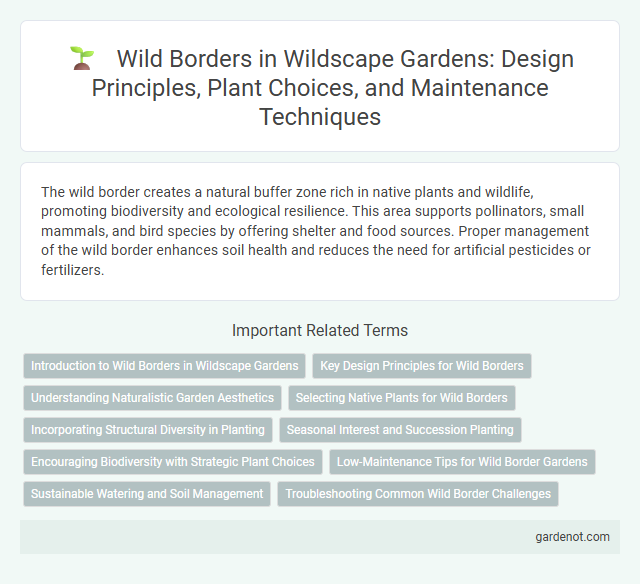The wild border creates a natural buffer zone rich in native plants and wildlife, promoting biodiversity and ecological resilience. This area supports pollinators, small mammals, and bird species by offering shelter and food sources. Proper management of the wild border enhances soil health and reduces the need for artificial pesticides or fertilizers.
Introduction to Wild Borders in Wildscape Gardens
Wild Borders in Wildscape Gardens create vibrant, ecologically rich planting zones that blend native flora with natural landscaping techniques. These borders enhance biodiversity by supporting pollinators and wildlife while offering an ever-changing palette of textures and colors throughout the seasons. Strategic layering of perennials, grasses, and shrubs in Wild Borders promotes soil health and sustainable garden ecosystems.
Key Design Principles for Wild Borders
Wild borders emphasize naturalistic planting schemes that blend native species to create seamless transitions between cultivated gardens and wilderness areas. Key design principles include layering vegetation for biodiversity, using succession planting to mimic natural growth patterns, and incorporating native pollinator-friendly plants to support local ecosystems. This approach enhances habitat connectivity while maintaining aesthetic appeal and ecological function.
Understanding Naturalistic Garden Aesthetics
Wild border designs emphasize naturalistic garden aesthetics by mimicking native plant communities and seasonal growth patterns. This approach prioritizes biodiversity, using shrubs, perennials, and grasses that provide habitat and food sources for local wildlife. The result is a dynamic, evolving edge that blends seamlessly with surrounding natural landscapes while enhancing ecological resilience.
Selecting Native Plants for Wild Borders
Selecting native plants for wild borders enhances biodiversity by supporting local pollinators and wildlife. Native species such as milkweed, coneflowers, and goldenrod thrive in local soil and climate conditions, requiring less maintenance and water. Incorporating a diverse mix of native grasses, wildflowers, and shrubs creates a resilient and ecologically balanced wild border that promotes habitat connectivity.
Incorporating Structural Diversity in Planting
Incorporating structural diversity in wild border planting enhances habitat complexity, supporting a wider range of wildlife species and promoting ecological resilience. Utilizing varying plant heights, textures, and flowering periods creates continuous resources for pollinators, birds, and beneficial insects throughout the seasons. This approach fosters natural regeneration, improves soil health, and strengthens the overall stability of the wildscape ecosystem.
Seasonal Interest and Succession Planting
Wild borders showcase a dynamic array of seasonal interest, featuring a diverse mix of perennials, grasses, and bulbs that provide continuous color and texture from early spring through late autumn. Succession planting strategies ensure that as one set of plants fades, another blooms, maintaining vibrant wildlife habitats and sustaining pollinators throughout changing seasons. Incorporating native species enhances ecosystem resilience while supporting local biodiversity year-round.
Encouraging Biodiversity with Strategic Plant Choices
Wild border gardens enhance biodiversity by incorporating native plant species that provide essential habitats and food sources for local wildlife. Strategic plant choices, such as flowering perennials, grasses, and shrubs, support pollinators like bees and butterflies while promoting soil health and reducing erosion. Implementing diverse plant layers creates interconnected ecosystems that foster resilience and naturally balanced habitats within wildscape designs.
Low-Maintenance Tips for Wild Border Gardens
Wild border gardens thrive with native plants requiring minimal watering and fertilizer, promoting sustainability and biodiversity. Incorporating drought-tolerant species, dense ground covers, and organic mulches helps suppress weeds and retain soil moisture effectively. Regular pruning and removing invasive species maintain plant health and encourage natural growth patterns without excessive upkeep.
Sustainable Watering and Soil Management
Wildscape's Wild Border incorporates sustainable watering techniques such as drip irrigation and rainwater harvesting to minimize water waste and promote efficient hydration of native flora. Soil management practices emphasize organic mulching, compost enrichment, and erosion control to enhance soil fertility and maintain ecosystem balance. These strategies collectively support biodiversity while reducing environmental impact and resource consumption.
Troubleshooting Common Wild Border Challenges
Wild Borders often encounter challenges such as uneven growth, invasive species intrusion, and soil erosion, which can disrupt ecosystem balance and aesthetic appeal. Effective troubleshooting involves regularly monitoring border health, applying targeted native plantings to outcompete invasives, and employing erosion control methods like mulching and contouring. Proper soil testing and adaptive maintenance practices enhance the resilience and biodiversity of Wild Borders over time.
Wild border Infographic

 gardenot.com
gardenot.com